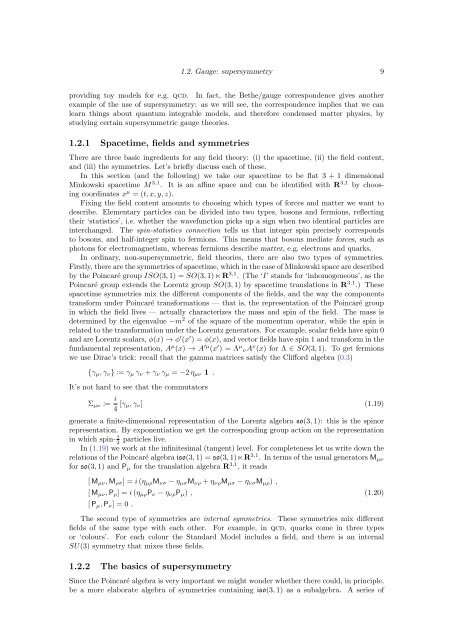The Bethe/Gauge Correspondence
The Bethe/Gauge Correspondence
The Bethe/Gauge Correspondence
Create successful ePaper yourself
Turn your PDF publications into a flip-book with our unique Google optimized e-Paper software.
1.2. <strong>Gauge</strong>: supersymmetry 9providing toy models for e.g. qcd. In fact, the <strong>Bethe</strong>/gauge correspondence gives anotherexample of the use of supersymmetry: as we will see, the correspondence implies that we canlearn things about quantum integrable models, and therefore condensed matter physics, bystudying certain supersymmetric gauge theories.1.2.1 Spacetime, fields and symmetries<strong>The</strong>re are three basic ingredients for any field theory: (i) the spacetime, (ii) the field content,and (iii) the symmetries. Let’s briefly discuss each of these.In this section (and the following) we take our spacetime to be flat 3 + 1 dimensionalMinkowski spacetime M 3,1 . It is an affine space and can be identified with R 3,1 by choosingcoordinates x µ = (t, x, y, z).Fixing the field content amounts to choosing which types of forces and matter we want todescribe. Elementary particles can be divided into two types, bosons and fermions, reflectingtheir ‘statistics’, i.e. whether the wavefunction picks up a sign when two identical particles areinterchanged. <strong>The</strong> spin-statistics connection tells us that integer spin precisely correspondsto bosons, and half-integer spin to fermions. This means that bosons mediate forces, such asphotons for electromagnetism, whereas fermions describe matter, e.g. electrons and quarks.In ordinary, non-supersymmetric, field theories, there are also two types of symmetries.Firstly, there are the symmetries of spacetime, which in the case of Minkowski space are describedby the Poincaré group ISO(3, 1) = SO(3, 1) ⋉ R 3,1 . (<strong>The</strong> ‘I’ stands for ‘inhomogeneous’, as thePoincaré group extends the Lorentz group SO(3, 1) by spacetime translations in R 3,1 .) <strong>The</strong>sespacetime symmetries mix the different components of the fields, and the way the componentstransform under Poincaré transformations — that is, the representation of the Poincaré groupin which the field lives — actually characterizes the mass and spin of the field. <strong>The</strong> mass isdetermined by the eigenvalue −m 2 of the square of the momentum operator, while the spin isrelated to the transformation under the Lorentz generators. For example, scalar fields have spin 0and are Lorentz scalars, φ(x) → φ ′ (x ′ ) = φ(x), and vector fields have spin 1 and transform in thefundamental representation, A µ (x) → A ′µ (x ′ ) = Λ µ νA ν (x) for Λ ∈ SO(3, 1). To get fermionswe use Dirac’s trick: recall that the gamma matrices satisfy the Clifford algebra (0.3){γ µ , γ ν } := γ µ γ ν + γ ν γ µ = −2 η µν 1 .It’s not hard to see that the commutatorsΣ µν := i 4 [γ µ, γ ν ] (1.19)generate a finite-dimensional representation of the Lorentz algebra so(3, 1): this is the spinorrepresentation. By exponentiation we get the corresponding group action on the representationin which spin- 1 2particles live.In (1.19) we work at the infinitesimal (tangent) level. For completeness let us write down therelations of the Poincaré algebra iso(3, 1) = so(3, 1)⋉R 3,1 . In terms of the usual generators M µνfor so(3, 1) and P µ for the translation algebra R 3,1 , it reads[ M µν , M ρσ ] = i (η µρ M νσ − η µσ M νρ + η νρ M µσ − η νσ M µρ ) ,[ M µν , P ρ ] = i (η µρ P ν − η νρ P µ ) , (1.20)[ P µ , P ν ] = 0 .<strong>The</strong> second type of symmetries are internal symmetries. <strong>The</strong>se symmetries mix differentfields of the same type with each other. For example, in qcd, quarks come in three typesor ‘colours’. For each colour the Standard Model includes a field, and there is an internalSU(3) symmetry that mixes these fields.1.2.2 <strong>The</strong> basics of supersymmetrySince the Poincaré algebra is very important we might wonder whether there could, in principle,be a more elaborate algebra of symmetries containing iso(3, 1) as a subalgebra. A series of
















